"What Does It Cost To Live In Panama?"
Your Cost of Living Will Be Higher if You Live In Either Panama City or An Ex-Pat Friendly Town
Discover all about these budget factors by reading each installment of "Your Monthly Panama Budget" series. This is my first post in the series.
Make sure you don't miss a future installment by subscribing to my monthly newsletter.
For budget purposes, you can divide Panama into 3 areas
Saving Money On Umbrellas in Panama City
Frankly, Panama City is no longer very affordable.
Well, maybe if you are willing to live in less desirable & less safe neighborhoods, live frugally, and hardly ever go out you can still live cheaply in Panama City. My guess is that you want a more comfortable lifestyle than that.
Last month we were in Panama City. We arrived directly from Seattle, USA. We noticed that Panama City is definitely cheaper than Seattle. However, you might not notice as much of a difference if you are from a town in the mid-west of the US or Canada. Seattle is a very expensive town.
However, compared to the rest of Panama, Panama City is definitely more expensive. For example, a small bottle of water in Panama City costs $1.25. The same bottle of water in Puerto Armuelles (1 day later) cost .75 cents. Almost half the price for the same exact brand of the same product.
Let me give you an example. For my kids Panama City is almost synonymous with gelato. We love the Dolce Idea gelato shop in El Congrejo neighborhood of Panama.
A scoop of gelato there sets you back about $2.50. Less than in Seattle, where a cone of Fainting Goat gelato costs you $4.00(!) Of course, I refuse to pay that in Seattle, but in Panama you could say we are regulars at the gelato place. Luckily for our budget (and waist-lines), we are hardly ever in Panama City.
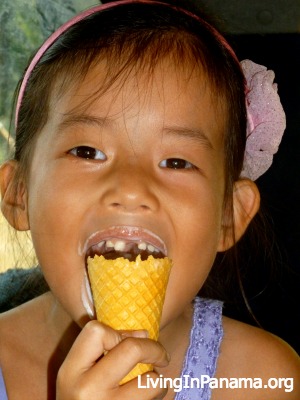
Very few places outside of Panama City have any gelato for sale. There is absolutely no place selling gelato in our town of Puerto Amuelles.
(Surprisingly, just last week Beyer's ice cream started to appear in the freezer section of the Romeros in Puerto Armuelles. A 1/2 gallon is selling for ~$6.30; much more than a 1/2 gallon of the local brand is $4.39.)
On Sundays, my family has a tradition of getting ice cream on our way to the beach. We stop at Puerto's Supermercado Mandarin. An ice cream cone there sets you back .60 cents. For a long time, it was only .25 cents, then about 1 year ago it went to .35 cents. Then almost overnight it jumped to .60 cents! I'm still recovering.)
I cannot imagine buying an ice cream for .60 cents anywhere in the States. Perhaps if you know where to go, which I don't, you could find it in Panama City, but I doubt it.
If you know of a place to buy an ice cream cone for .35 cents in Panama City, please let all of us know in the comment section below.
Temptations in Panama City go far beyond gelato. Panama City offers specialty stores like Super Kosher supermarket, Super Deli K Market, and Super Gourmet deli. All offer a wide range of imported and delicious grocery items So many temptations on your wallet.
To give you an idea of the offerings, check out Super Gourmet's menu.
Panama City is also the only location with the Riba Smith supermarkets. Riba Smith is the most likely store to have your favorite foods from home. You can browse Riba Smith's selection and prices here.
To give you an idea of prices, lets look at beer prices at Riba Smith. As you can see by looking at the prices in the link above, imported items cost more.
I will go into food costs in a future post, for now just know that imported good cost more than locally produced items.
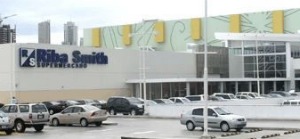
Riba Smith Supermarket located at Multiplaza Mall. This is the one we have gone to. Photo: RibaSmith.com
Every once in awhile the Romero grocery store in Puerto has a microbrew for sale, specifically Fullers of England. It is equally as expensive as the Sierra Nevada above, but I almost never have the opportunity to buy it. I think there are about 12 of those beers in stock about once a year. I definitely plan on buying some when Romero's finally stocks them again. But my budget is happy that it happens so rarely.
The opportunities to spend more than your budget are not limited to grocery stores.
Below, I have put together an estimated monthly budget for a couple in Panama City.
In Panama, it is common to buy your home outright, or at most over 2-3 years. Therefore, you have no monthly housing costs. Well except for your property taxes (if titled) and, of course, maintenance, remodeling, etc... However, utilities and other home-related expenses are included in the budget below.
It is not only dependent upon your location, but on your lifestyle choices.
By living much more like a local, you could lower the above budget significantly.
You will have a very different lifestyle in Panama City than you will in the small mountain town of Volcan.
Only you know which lifestyle suits you.
For instance, it may take more time to find an affordable apartment in the area you want to live, but often it can be accomplished with alot of persistence.
The Panama Guide asked people to submit their monthly budgets. I have included those budgets on another page on my site. The budgets that were submitted include some from people living in Panama City. Click to read expat budgets in Panama.
President Varela & First Lady On Induction Day
Juan Carlos Varela, 50, is from one of Panama's richest families. The family owns and operates the country's biggest liquor producer, Varela Hermanos S.A., which was established in 1908.
Varela graduated from Georgia Institute of Technology in 1985 with a BA in industrial engineering.
He is married to the journalist Lorena Castillo and has three children.
Varela has been on the board of the family business since 1985 and was executive vice president of the company until 2008.
He started in politics in the 1990s. In 1994 he become chief of political campaigns for the Panama's 2nd largest party, the Panameñista Party. In 2006 he became the head of the party and then the Panameñista Party's 2009 presidential candidate.
In a bold move, Varela withdrew his 2009 presidential candidacy to throw his conservative Panamenista party's support behind Martinelli. He did this in exchange for becoming Martinelli's vice-presidential candidate. It was a successful move. On May 3, 2009, was sworn in as Vice-President of Panama.
As Vice President, Varela was the architect of the government’s popular “100 for 70″ program. The program gives $100 monthly to Panamanians over age 70 who do not receive any other pension or retirement benefits.
But the political marriage didn't last. In 2011, Martinelli stripped Varela of his role as foreign minister for refusing to back a plan for a referendum to allow president's to serve consecutive terms. (Note: Panama law requires that a president cannot run for president again until 2 terms (10 years) have passed since he or she last held office.)
Since that rupture, Martinelli and Varela have been fierce critics of the other. Varela has accused Martinelli of many corruption charges including taking kickbacks for a government radar system contract with Italy's Finmeccanica.
It was one of the toughest-fought contests since democracy was restored two decades ago.
Election day began with opinion polls indicating a tight race among the top 3 candidates. However, not one of the pollsters had Varela in the lead. Most gave a slight edge to Arias.
Martinelli was extremely eager for his protege and political newcomer, Jose Domingo Arias to win.
Many people think Martinelli's endorsement of Arias was really a badly disguised ploy to retain his political power.
Although, blood relatives of the president are banned from running for the top 2 offices, Martinelli's wife, Marta Linares, ran as Arias's vice presidential candidate. Technically legal, since Linares is not a blood relative; but not surprisingly, there were many cries of illegality.
In addition, sitting presidents are banned from campaigning for a presidential candidate. Martinelli defied this injunction and campaigned for Arias furiously throughout the country.
Varela was a surprise upset.
Varela won the presidency with 39 percent of the vote, compared to 32 percent for outgoing President Martinell's choice, Jose Arias. Juan Carlos Navarro, a former mayor of the capital, got 28 percent to finish third in the seven-candidate field.
The win is being interpreted as a rebuke to Martinelli.
Verela was sworn into office for a 5 year term on July 1, 2014.
Martinelli's initial reaction was, "May God help us". Since then he has calmed down and mouthed all the usual and expected political niceties.
While Varela won the presidency, his party did not win the legislature.
He takes office with a legislative minority. This will make it harder for him to pass free-market legislation. He will have to negotiate with the centrist and center-left politicians that currently dominate Panama's Congress.
Varela promised upon taking office to take immediately steps to reduce violence and control the price of food.
He did both. On Induction Day, he signed into law price controls on 22 common food items such as rice, milk, and beef. The controls start today, July 7th, and last for 6 months.
He has also granted a one month amnesty for gang members to allow them to turn in their weapons.
During his campaign Varela has vowed to continue Martinelli's drive to improve Panama's infrastructure. Continual progress in improving infrastructure was the most cited reason for President Martinelli's 60 percent approval rating.
But he also vowed to boost transparency. It is a common perception that much of the $15 billion spent on infrastructure upgrades was lost to corruption and poor planning.
Of course he has also committed to maintaining the country's record-low unemployment rate and strong economic growth. Growth that has averaged over 8 percent in recent years.
His biggest theme is his pledge to govern with honesty and transparency.
I hope it is true and I wish him luck.
Hard At Work on 4 Lane Highway Expansion (scroll down for slideshow)Of course, soon is a relative term, especially in Central America. But Panama can be astoundingly quick at road construction.
I took these photos of the construction in early June 2014.
Click on any photo to start the slideshow.
(FYI: The article continues below the slide show)
The biggest stumbling block will most likely be the bridges. While work is being done on them, it is not anywhere near as complete as the road.
For example, the west-bound bridge that washed out a couple of years ago between David and Panama is still not rebuilt. That bridge has been out for most of our 8 years here. It was finally rebuilt but only functioned for about 1 year, when it washed out. I remember it well since my family and I crossed it less than 30 minutes before it washed away. No one was hurt.
They simply hadn't put in sufficient pilings. Hopefully they have learned their lesson. I find it encouraging that I am seeing lots of rebar being used in the construction of the bridge right out of my town.
As some of you may know, we only recently returned to Puerto after a much longer than expected visit to the states. It is astounding the number of new things that have happened while we were gone. There seems to be even more energy and new people in town.
The new road, when it is complete is sure to bring even more vitality to this beautiful beach town that Chiquita built.
In fact, the rumors that Chiquita is returning seem to be coming true as well. More on that in another post.
Updated July 4, 2017
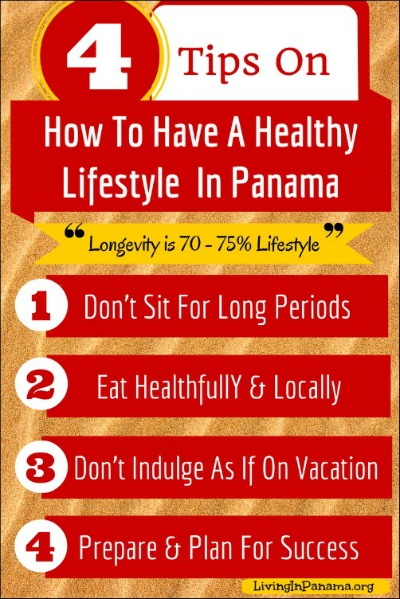
Read this post for details on how to be healthy in the tropics
While there are health food stores and gyms in many locations, they are not available everywhere. Even when they are, they might not be up to the same standard as your gym at home.
And what you eat is only one factor.
Maintaining a healthy lifestyle - with exercise - is also a challenge.
Suddenly being in a totally new culture, and often hotter climate can sometimes change an energetic and engaged person into a sedentary and lazy person. But that is easily remedied.
"We think longevity is probably about 70- 75% lifestyle."
Don't let the heat prevent you from keeping active. As the quote above indicates, you are the captain of how healthy and fit you are as you age. Your genes are not the prime reason for how you age.
You are in charge of 75% of how you will age. A key way to keep healthy and active is to keep moving. Even a regular morning jog cannot overcome the negative impact of sitting for long periods during the day.
The various studies show: no matter how "fit" subjects were, extended bouts of inactivity increased a subject's risk for:
Here are some ideas for integrating activity throughout your day.
One of the wonderful aspects of living in Panama is that nature is never far away. Go explore the tropical paradise around you, and make sure to move your body while you do it. To avoid the heat, do your most strenuous exercising in the early morning or evening hours.
You can grow your own food or buy from the many fruit and vegetable stands in Panama.
Buying your produce from street stalls is not only a great way to meet and greet people in the community, but you are supporting local business. Also, the produce is usually much cheaper than in the grocery store.
You may want to read this post about buying local produce in Panama.
In Chiriqui, we have a great resource in Finca Santa Marta. It is a 42-acre organic farm in Santa Marta, about 20 minutes west of David. They offer a wide range of organic items:
How To Shop From The Farm
Pick up Orders. You can pick up your order on Tuesdays. That is, from the Boquete Market on Tuesday morning or in Dolega or David on Tuesday afternoons. Order deadline for a Tuesday pickup: Monday at 7:00 am.
Deliveries. They offer deliveries of prepaid orders on Thursdays for any area served by Uno Express. For example, they deliver to: Bocas del Toro, Santiago, Las Tablas, Coronado, El Valle, Altos del Maria, Gorgona, La Chorrera, Panama City, Colon, and Puerto Armuelles. They also offer deliveries to Volcan on Fridays afternoons.
To initially set up deliveries, you will need to contact Richard, the bi-lingual farm manager, at 6242-9308. He is available Monday - Saturday from 7am-7pm. You will also need to set up an account on their website.
Facebook page: They have a facebook page too.
Phone Finca Santa Marta at 6242-9308 or 777-9229 or 540-560-9680 (USA cell phone) for further information.
Growing your own vegetables is also a good way to ensure you have a sufficient supply of basil, spinach, and other vegetables that you may love, but are not commonly grown or sold in Panama. You can also learn how to grow various indigenous fruits and vegetables. If you want to grow pineapples, we have a brief guide on how in this pineapple post.
Gardening is also a good way to keep active as well.
You are living in the tropics. The palm trees, coconuts, and warm sunny weather inspire all of us with visions of hanging out in a hammock sipping margaritas.
Life near the equator is more relaxed and carefree. However, sometimes new expats treat themselves as if they are on an extended vacation. The cocktail hours begins earlier and earlier in the day. Hammock time and indulging in special treats will become the norm.
While feeling like you’re on a permanent vacation is great, developing a habit of unhealthy indulgence is far from ideal. Too many indulgences can make you feel sluggish and unmotivated. It is better to develop healthy indulgences. You can try to make daily yoga, beach walks, sunset gazing, and cooking a healthy meal your new indulgences.
For most of us, the point of retiring is not to create a life of doing nothing. The idea was to engage in activities that you enjoy, to learn new activities, and to relish life.
So whatever it is you wanted to do before you moved to the tropics, do it.
Also be on the lookout for new activities and learning opportunities you can engage in.
For the most part, the more active and engaged you are more motivated and energetic you become.
Planning ahead can help you accomplish your goal of a healthy lifestyle.
Find out all the ways you can keep active. You are much more likely to keep active if you start by being active. Knowing that lapsing into a sedentary lifestyle is a danger, start scoping out your possibilities
Buy the seeds for your ideal garden. If you plan on gardening, arrange to have seeds of your favorite vegetable. Sometimes it takes a little searching to find seeds that thrive in tropical environments. Of course, you can also ask people in the area for the seeds from their produce. Ask people for tips on what grows best and how to grow those items.
Find out what organic produce is available in your area. Check out Finca Santa Marta's website and see how you can integrate their organic produce, meat, eggs, and more in your life.
Bring healthy cookbooks that have recipes featuring the produce that grows in your area. The best produce to use in your cooking is locally grown and organic. Panama offers a number of fruits and vegetables that will be new to most expats. If you like to cook, it is fun to explore these new Panamanian foods and recipes.
Discover all the different things you can do in your area.
To discover some of the outdoor pursuits you can enjoy in the Puerto Armuelles, click here. I am sure other websites have also listed activities available in their areas.
Check out more ideas for happiness-enhancing hobbies to pursue in Panama
With some planning, it will be fairly easy to achieve the tropical lifestyle you have been dreaming about.
Most Full-time Expats Are Exempt From ObamaCare
Medicare qualifies as meeting the "minimum care requirement" so you don't need to sign up for ObamaCare, nor pay any fee for not participating.
If you are not on Medicare, TRICARE, or other health plan that covers you in the US, it can get more complicated.
Although, if you are a full-time expat, you are probably exempt regardless of your healthcare coverage.
ObamaCare In A Nutshell
All Americans must have healthcare. Furthermore, all Americans must share responsibility for ensuring this health care coverage.
Therefore, every US resident must obtain minimum health care coverage or be subject to additional taxes. These additional taxes help fund health care for those who cannot afford it by themselves.
If you aren't a US resident, you are exempt from the Affordable Care Act. That means the majority of expats are exempt from ObamaCare.
ObamaCare uses the IRS's definition and tests to determine if you are an expat.
The IRS Uses 2 tests to determine if you are an expat, for the purposes of Obamacare participation.
1) 330 Day Abroad “Physical Presence Test” - To qualify, you need to be out of the US 330 days out of a 365 day period. That is, in any given 12 month period, you can only be in the US for a maximum of 35 days.
If you cannot pass that expat test, then you can try to pass the more difficult and IRS-reviewed "Bona Fide Residence" test.
2) “Bona Fide Residence Test” To qualify, you need to be living abroad for at least one year and have no immediate plans to return to the US on a permanent basis. This is a much more complicated test to prove and pass. For more information on this, please visit IRS's Publication 54 at http://www.irs.gov/pub/irs-pdf/p54.pdf .
If you pass either of these 2 tests, you qualify for foreign residency, that is you are an official expat, according to the US Government.
That means, since you are not a resident of the US, you don't need to procure the "minimum care coverage".
It does not matter what, if any, health care you have in your official ex-pat residence. ObamaCare only applies to health care while in the US.
If you don't pass either of the expat-qualifying tests above, you still may not have to do anything new or different to comply with ObamaCare.
Remember, the point of the Affordable Care Act (ACA) is for all US residents to have minimum healthcare coverage. So if you already have qualifying health care while in the US, you are sitting pretty.
If you are not an expat (per the IRS) AND don't have ACA-qualifying healthcare (see bullets immediately above),
Then you must take action to comply with ObamaCare.
Part-time US residents must have US healthcare coverage. You need to obtain minimum coverage within 30 days of returning to the USA.
You Have 4 Options For Coverage
In 2014 the fee is $95 per person per year or 1% of income, whichever is greater. If you chose this no insurance option, I don't know what your potential cost will be if you do have a catastrophic event while in the US. It could eat up all your assets. Or if you have no assets, it could be free if you show up at the ER of a public hospital. US law requires public hospitals to treat emergency indigent patients for free.
Of course, if your income is below the IRS filing limits, then you are exempt from the Affordable Care Act. See the Resource section below for links to discover if you qualify.
State health insurance exchanges are insurance pools for each US state that cover people who either cannot afford or cannot get medical insurance coverage. State Medicaid programs are projected to increase per the ACA, but many many physicians refuse to take Medicaid patients. The State Exchanges are expected to fill in this gap. The ACA will reimburse the States 100% of the costs of these exchanges from 2014 through 2016. Then the Federal Government is proposing to reimburse the States 90% of these health care costs.
States have either implemented a state run health insurance exchange, or let the federal government run the health insurance exchange for them. For more information on these exchanges and to see if your state runs their own, go here. Regardless of who runs the exchange in your state, you can access it by using the main Federal ACA Marketplace site, https://www.healthcare.gov/.
You can sign up for a state exchange when you return to the US, or you can start the process from outside the USA.
You must be a resident of a state to apply. You can use your own US address, or if you don't have one, you can use the address of a friend or family member willing to say that their address will also be your residence.
You don't have to worry about the open enrollment periods. There are special rules that allow people to sign up for insurance, even outside the open enrollment periods.
If you decide not to apply before you arrive in the States, you can get a travel insurance policy to cover you until your US insurance kicks in.
Remember, you need to obtain minimum health care coverage within 30 days of returning to the USA.
The ACA penalty fees are only incurred for the months in which you don't have health care coverage. If you are on a qualifying plan for even one day in a month, you are considered covered for that month. The non-comply fees increase over the next 3 years.
The information in this post applies whether you live in Panama or in another country. I have tried to layout the ObamaCare situation for expats as clearly as I can. However, I am not an expert about the ACA rules you need to follow. I recommend exploring further resources to determine your best response to Obamacare in your unique situation. I have listed some other resources, by category, below.
There are more details on various exemptions to ACA as well as how to qualify as a expat or non-resident US citizen at https://www.healthcare.gov/exemptions/.
To find out more about whether US citizens living abroad are subject to the individual shared responsibility provision. go here:
http://www.irs.gov/uac/Questions-and-Answers-on-the-Individual-Shared-Responsibility-Provision
For the nitty-gritty details on whether and how to qualify for an exemption if you live abroad, go here:
http://www.irs.gov/pub/irs-pdf/p54.pdf
If your income is low enough, you are not required to file a tax return with the IRS, which means you have no responsibilities under the ACA. To find out if you are required to file a federal tax return, use the IRS Interactive Tax Assistant (ITA).
Also read item 6.5 at http://www.irs.gov/uac/Questions-and-Answers-on-the-Individual-Shared-Responsibility-Provision
A useful tax document for all US Citizens that live overseas to read is the "Tax Guide for U.S. Citizen and Resident Aliens Abroad". Read it by clicking on
http://www.irs.gov/pub/irs-pdf/p54.pdf
On this government site you can
Keep in mind that the plans offered via the MarketPlace only covers care in the US. For 2014, open enrollment ends on March 31, 2014.
The page to visit is https://www.healthcare.gov/marketplace/individual/.
Most people will be eligible for health coverage through the Health Insurance Marketplace. Discover if you are, visit
https://www.healthcare.gov/am-i-eligible-for-coverage-in-the-marketplace/
Learn About State Exchanges
This site will answer many of your questions about the coverage in your state, especially if your state opted to have their own health exchange program. The federal government is still figuring out the rules for the states that did not opt to run it themselves.
http://obamacarefacts.com/state-health-insurance-exchange.php
You can buy state exchange health insurance via the marketplace, at https://www.healthcare.gov/marketplace/individual/. That site will redirect you to your individual state health exchange site, if your state opted to run their own exchange. Otherwise you will stay on the federal site to purchase (or learn about) your health insurance options.
Question Clearinghouse
The federal government set up a site to try to answer all your Affordable Care Act Questions: https://www.healthcare.gov/
The Federal government also has a health care help line set up
1-800-318-2596 - open 24 hours a day, 7 days a week
Other blogs that have useful information
In my research, I found the following 2 blogs had very useful information. I am especially indebted to the information I found in the first one listed below, yucalandia.com.
I hope this information was helpful to you. Please comment below.
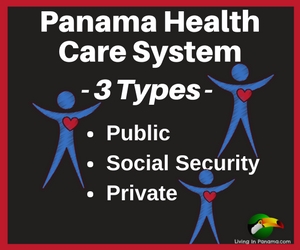
This is Panama's National Heath Care which is administered by its Ministry of Health. The are designed to serve the poorest of the poor. You can easily identify their clinics.
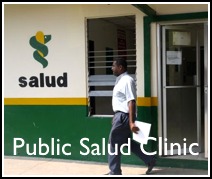
Where to go for free or low-cost health care
They are all painted white with a green and yellow logo and the word Salud (health) on them. You will find these clinics in all but the smallest villages.
It is a basically “free” or “low cost” health care. You can expect to pay 50 cents to see a doctor, plus the cost of some more expensive medications. These clinics exist to treat Panama's extremely poor, who are also mostly Indigenous. The indigenous population who rely on these clinics primarily live in remote and rural areas. Unfortunately, the more remote the location, usually translates into lower quality of care. The best and brightest aren't choosing to live in those locations. Like most government run enterprises in Panama, the National Health care system is plagued by inefficiency and bureaucracy. However, it is a great compliment to Panama that they strive to provide health care to the poorest of the poor. It is a hard job and they dedicate a sizable chunk of their budget to make it a realty.
You don't have to be poor to be treated at these clinics. When we were traveling we went to one such clinic in Boquete. One thing that was a little troubling to us is that we were whisked right in to see the doctor even though other people were waiting. We were stunned at the low cost we paid, we went for a minor reason and could not fault with our service.
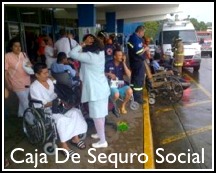
Subsidized health care for workers at Social Security Hospitals
Most working people, and their immediate family, have access to the Social Security health care system administered by Caja de Seguro Social (CSS). Everyone who works in Panama is required by law to pay into the Panamanian Social Security system. However some workers ask their employers not to do it because they want a higher paycheck now. By paying into Social Security an employee is both gaining immediate access to health care each month he or she works, they are also putting money into the pension system that will kick when they retire. About 70% of Panamanian's use this social security system.
Panamanians Go To The Hospital With The Slightest Sniffle
Panamanians are huge believers in going to the doctor about the slightest problem. Which means they often go to the hospital. At first when you hear that someone's brother had to go to the hospital you say, "oh I am so sorry. What is wrong?" You quickly discover that in Panama people go to the hospital for the slightest aliment. The social security system is mostly comprised of hospitals, so they go to the hospital to see a doctor.
Keep in mind that all doctors, even those in private clinics, are required to attend at the local social security hospital. Some doctors only attend at social security hospitals. The quality of care can vary greatly depending upon the doctor you draw.
Long lines, understaffed, and plagued by inefficiency and bureaucracy. Often doctors prescribe drugs that are supposed to be “free” but the Social Security system doesn’t have them, so users must buy them at pharmacies. Pharmacies sell drugs here by the pill. So if your doctor prescribes something, you buy only as many as you can afford, when you can afford them!
I wrote about one visit we made to the emergency room at our local social security hospital, read about it here.
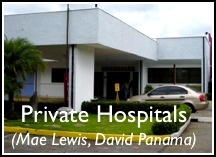
Many expats use Panama's private health care system
This is the system used by many middle and upper class Panamanians, by expats, and by the increasing number of people who are coming to Panama on a “medical tourism" trip. If you don't want to wait for days, weeks, and sometimes months for a procedure at the Social Security hospital, go to one of the private hospitals. The private system is more expensive, but it is alot faster, and you will more often find doctors who speak English. Although the private system is more expensive, relative to health care in the US, it is affordable.
Our go to clinic/hospital is Mae Lewis in David. We have had nothing but good service there. Panama City has excellent private hospitals. If you cannot get something done in David or elsewhere in Panama, Panama City usually offers it.
Often the same doctors work in both the public and private systems.
[leadplayer_vid id="5221A646E4710"]
One person, the more agile one in the team, climbs the tree. He then collects the mangos in a handmade net on a long pole (see the photo below.)
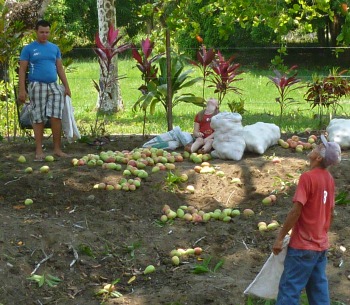
Then he hurls these mangos down to his comrades on the ground. The guys soften the mango's fall by "catching" them using an old feed bag, as seen in the video.
Later the mangos are counted and put in the bags or put loose in the back of a truck.
A Mango snareMangos are counted because the pickers pay you for each mango they pick.
Counting & Bagging MangosThere is significant of money in Mango picking. Therefore, if you have a good tree, you will get visits even before the mangos are ripe enough for green mango salad. They will be to see if they the tree when the time comes.
I advise selecting the Mango=person early in this process otherwise you will continue to get visits from these hopeful mango pickers.
July 2013
Listen in below.
[leadplayer_vid id="522199A9F14AC"]
Us: Hello, this is Betsy and Reyn, with Living in Panama,
and today we are talking with Leif Simon about the cost of living in Panama.
Hi Leif, it's Betsy and my husband Reyn.
Lief: How are you doing?
Hi Reyn.
I'm good, how are you?
Us: Leif is not only an authority on Panama, having lived in Panama City, with his wife Katherine Peddicord,and their two children for the last several years,but he is an international real estate expert.
Welcome Leif, to Living in Panama with Betsy and Reyn!
Lief: Thank you guys, I'm happy to be here.
I think one of the reasons people often think about moving to Panama, is because they hear that it has a really low cost of living.
Some people couldn't afford the lifestyle they'd like to become accustomed to in the United States or Canada,or other places, are starting to think about Panama.
Us: What are your thoughts about the cost of living in Panama?
What generally do you think you could live on, and what kind of lifestyle would that give you?
And is it true that it's more affordable?
Lief: Yeah.The cost of living conversations that we have with people that vary in the gambit.
You can live off of your social security in Panama.
Us: What does that buy you?
Lief: It can buy your a beach lifestyle,like what you guys have in Puerto Armuelles,
where you can live off maybe $1000, $1200 a month.
That's not going to be luxurious,but where in the U. S are you going to live on the beach on $1200 a month?
So, you know, people come from Iowa, say,"Oh Goodness, Panama City is so expensive!"
Well, of course it is, if you're coming from Des Moines,it's going to be more expensive.
If you're coming from the West Coast or the East Coast,or any major city in between,
Panama City is going to be likely less expensive.
And you can live inexpensively in Panama City.
We know a guy, it's been a couple years since I have spoken with him, but he was living
here on his social security, and it was less than $1000 a month.
Us: Wow.
Lief: Biggest portion went to his rent, he was renting a house in a decent neighborhood, not one of the high end neighborhoods, but a decent,local, safe neighborhood for $650 a month,and the rest of it went to food.
He didn't run his air conditioner 24 hours a day, and he didn't have a car, but he was happy.
He walked and it went around by taxi and bus, and he was living on less than $1000 in the city.
On the other hand, you can spend as much as $5000 a month in a high-rise apartment,
overlooking the ocean.
You're budget can go to the extreme the other way in the city as well.
But overall, I think most places, if you're in that $1500 to $2000 a month budget range,
you can have a great lifestyle in lots of areas in the country.
Us: It sounds like if you bought property right, you had your own house, if you had the capital to do that, then you'd have even a lot more money to spend on living expenses.
Lief: Absolutely, and that's when we talk about budgets,we try and separate housing, because housing can be whatever you want it to be.
It can be a one bedroom, small, little apartment, or it can be a five bedroom,
two million dollar house.
Take that part [housing] out of it, and then you're looking at the cost of food for example.
And food costs in Panama are goIng to be less.
Unless you're buying the processed foods that they ship in from the U. S, in which case they are going to be the same or more.
So, you have to make a bit of a shift in your expectations if you want to save a lot of money.
But you can have all the comforts at home in Panama as well.
Us: For more on the cost of living in Panama, please click the link below.
Thanks for watching!
Start here for more information on cost of living in Panama.
July 27, 2013
The International Air Transport Association (IATA) is the trade association for the world’s airlines, representing about 80% of the world's airlines. Their site is helpful.
It provides a list of items to consider when transporting a pet including, airline regulations, government regulations, and the pet itself. For those IATA guidelines, click here.
If you are transporting only one animal — especially if it can travel in the cabin under the seat — you shouldn’t have a lot of difficulty bringing your pet with you to Panama.
Of course, you still must do all the paperwork and your pet must be healthy. However, the process will be pretty straightforward and not very expensive.
It can get more complicated when you have larger or multiple pets.
The Government requires strict adherence to the rules.
You must have the following:
Vaccinations and their documentation
Health Ministry "Home Quarantine" process costs $130.00 per pet.
Your pet's entry into Panama will only be processed Monday through Friday from 8 am to 10pm.
If your pet arrives outside of those times, or on a holiday, your pet will be kept in an airport kennel until the office opens again.
You must check with your airline.
They all have different rules. Some of which include:
Allow your pet to spend time in its travel crate before your trip. Travel is stressful for animals. Getting familiar with its new crate is important. You may want to put a worn T-shirt, or other item, that has your scent on it in the crate with your animal. Unless advised otherwise by your vet, you should not sedate your animal. This is to avoid any unexpected health complications.
Upon leaving the airport, your animal is officially in home quarantine for 30 days. This means that your dog must stay with you at all times for the next 30 days. Sometime during the quarantine period, you will be contacted to ensure that your dog is still healthy.
Once the 30 days have passed, your dog is free from quarantine restrictions.
My older daughter is always asking to bring our dog with us when we visit the States. I have always said no because I fear it is a difficult task. I have heard that you must visit 3 different Panama Ministries and get 3 separate stamps to get the dog out of Panama and into the U.S.A
However, I have not confirmed that process. In a future post I will cover taking pets out of Panama.
FYI , for those of you simply visiting Panama for a short while (i.e., less than 31 days), you don't have to do get all those stamps to bring your pet back with you.
We have never taken a pet to or from Panama. I owe my knowledge to a number of sources, including
Please comment below.